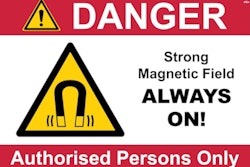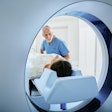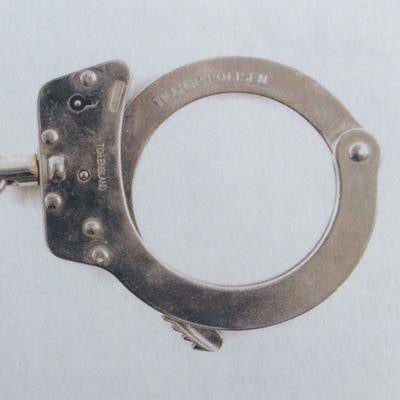
The detailed forensic evidence presented in the 195-page police report on the serious MRI accident in Swedish Lapland contains photos and descriptions of the metallic objects that were effectively turned into flying weapons before they became attached to the scanner.
On 13 March, AuntMinnieEurope.com revealed details about the weighted vest worn by the specialist nurse who got sucked into the MRI machine in October 2019. The police report, finalized on 24 February, also indicates that a set of nickel-plated steel handcuffs and a baton were pulled into the magnet when security guards tried to rescue the nurse.
The handcuffs are made by TCH in Birmingham, U.K. The model name/number is TCH 802, and they weigh around 260 grams (almost 9.2 ounces), according to the report.
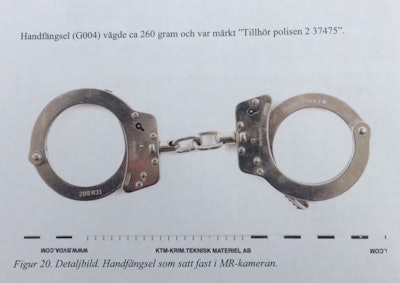 The British-made handcuffs and aluminum baton found in the mobile unit located outside Sunderby Hospital in Luleå, where the accident happened. All photos courtesy of the Swedish police.
The British-made handcuffs and aluminum baton found in the mobile unit located outside Sunderby Hospital in Luleå, where the accident happened. All photos courtesy of the Swedish police.The baton, on the other hand, is 34 cm-long and made from aluminum (but presumably not 100% aluminum). It weighs around 565 grams (20 ounces) and is approved by the National Police Board.
In addition to the vest and weights, a heavy-duty Velcro strap was retrieved from the scene, although no separate photo of the strap is included. Some media reports have asserted that a handgun carried by a security guard was also sucked into the scanner, but there is no reference to any gun in the forensic information.
What's happened to the nurse?
In another recent development, it's been reported in the local media that the nurse returned to work on 1 February 2020, and in his new job, apparently he is active in promoting MRI safety and collaborating with colleagues from other disciplines.
The nurse is now a full-time employee of Aleris, the company that owned and operated the mobile unit in which the accident happened, whereas in October 2019 he was only a part-time or casual worker who was paid by the hour, stated an article posted on 5 March by Vårdfokus, the journal of Vårdförbundet (care association), which is a Swedish association representing over 114,000 qualified midwives, biomedical analysts, x-ray nurses, nurses, and students.
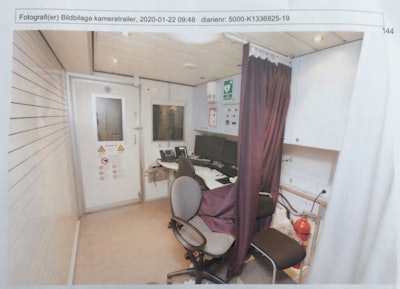 The reporting room in the Aleris-owned mobile unit is shown after the accident happened.
The reporting room in the Aleris-owned mobile unit is shown after the accident happened.Vårdfokus claims to have been given access to Aleris' internal investigation, which it said reveals that the weighted vest worn by the nurse was brought into the MRI unit by the patient.
"The patient was wearing a 13 kg weighted vest. She/he wanted the x-ray nurse to try on the weighted vest and therefore hung it over his shoulders and then clasped the buckle. The x-ray nurse tried to get the vest off, but was unsuccessful," the article noted.
The nurse reportedly said he did not know what material the vest was made from or what it contained, so he thought it was safe to stand in the doorway, Vårdfokus continued.
"According to the calculations performed during the preliminary investigation, he must have come further into the [scanning] room to be drawn into the magnetic field's force field. There is no information on how this has happened," it pointed out. "In light of the above, it is not possible to prove that the x-ray nurse has not consciously taken any risk. It was not possible to prove that he acted with gross negligence."
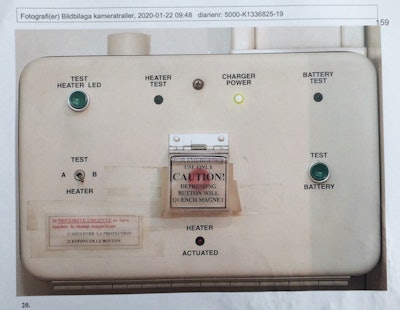 A photo of the emergency button in the mobile unit at Luleå. Quenching a magnet involves turning off the magnetic field, and the button should only be used in a life-threatening emergency. It places the scanner out of service for a week or more, may damage the magnet, and costs over 30,000 euros to replace the lost liquid helium, MRI Questions explains.
A photo of the emergency button in the mobile unit at Luleå. Quenching a magnet involves turning off the magnetic field, and the button should only be used in a life-threatening emergency. It places the scanner out of service for a week or more, may damage the magnet, and costs over 30,000 euros to replace the lost liquid helium, MRI Questions explains.This incident involved a person who always strives to do right and good things, and he is very caring about patients, so there was great relief when news came about the closure of the case, Ulrika Ask, chief operating officer at Aleris X-ray in Sweden, told Vårdfokus.
The case has not closed completely for Aleris, however. The Swedish Work Environment Authority has stipulated that by May 2020, the company must report to them about additional technical and structural solutions that can increase safety, the article stated. Areas being looked at include the following:
- The introduction of alarms outside the examination room
- Making improvements to patient information sheets; e.g., spell out that it is forbidden to carry weighted belts and weighted vests
- To consider more team working by nurses; the risk, however, is that if you increase the number of nurses to two per examination, then it becomes unclear who has the main responsibility, according to Ask
 The inside of the scanner gantry in the mobile unit.
The inside of the scanner gantry in the mobile unit.Vårdfokus said it has asked for an interview with the specialist nurse involved in the accident but has been unsuccessful in obtaining one.







